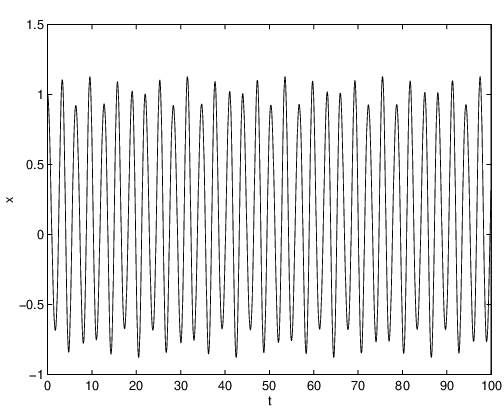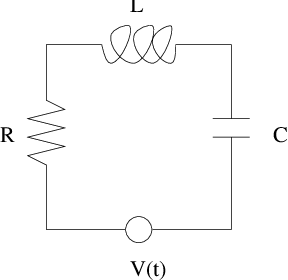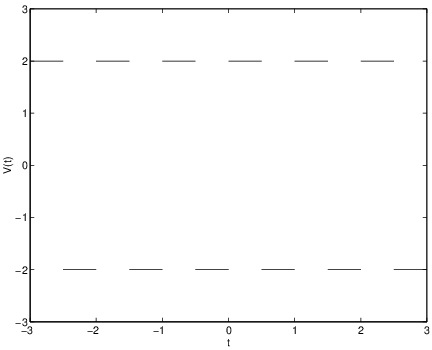RLC circuits provide an excellent example of a physical system that is well modeled by a second order linear differential equation that is periodically forced by a discontinuous function. Consider the electrical circuit shown in Figure ??. The circuit consists of a resistor with resistance , a coil with inductance , a capacitor with capacitance , and a voltage source producing a time dependent voltage .
We describe the behavior of the circuit by the voltage drop at the capacitor. Kirchhoff’s Laws for electric circuits show that satisfies the second order differential equation
as we now explain. Kirchhoff’s Voltage Law states that at each instant of time the voltage produced at the source is equal to the sum of the voltage drops at the three elements of the circuit. So, if we denote the voltage drops at the coil by and at the resistor by , then we have recalling that is the voltage drop at the capacitor.Let be the current through the system. Then
- The voltage drop in a capacitor is proportional to the charge difference between the two plates: where is the capacitance measured in farads. The charge difference itself is related to the current by
- The voltage drop at a resistor is proportional to the current: where is the resistance measured in ohms.
- The voltage drop in a coil is given by Faraday’s Law; the drop is proportional to the rate of change of the current: where is the inductance of the coil measured in henrys.
Combining (a,b,c) with (??), we obtain the differential equation: After dividing by , we obtain the second order equation (??); and, on setting we have an initial value problem in the form (??).
A typical input at the voltage source (associated to alternating current) is a -periodic square wave with amplitude defined by periodicity and See Figure ??. We will see how to use Laplace transforms to solve second order equations with a discontinuous forcing of this type. Indeed, it is the possibility of using Laplace transforms to solve linear equations with piecewise smooth forcing terms that is the main strength of Laplace transforms.
Piecewise Smooth Periodic Forcing
We now show how Laplace transforms can be used to solve second order equations with periodic discontinuous forcing. As an example we consider the equation (??) where the external force is given by
We begin by computing the Laplace transform of . Using the definition we obtain

